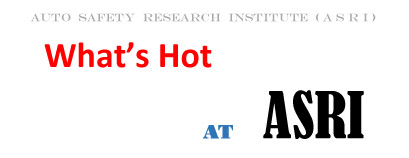

|
On February 15, 2024, about 6:42 a.m. pacific standard time, the driver of a compressed natural gas (CNG)-powered truck-tractor noticed sparks coming from below the passenger-side seat. The driver parked the vehicle and called 911.The truck was fully engulfed in flames when the fire department arrived. During the course of firefighting, the driver's side CNG tank exploded injuring 9 firefighters - two of them seriously. Research to address the fire safety of high pressure fuel tanks has been conducted by a related non-profit institute and is summarized here. ASRI presented two papers at the International ESV Conference in Yokohama, Japan, April 2023. One described factors that influence the injury risks for females and the second recommended methods for rating the safety of vehicles for females. The 2021 Genesis GV80 is among the few cars sold in the US with a center airbag that is designed to meet the EuroNCAP far-side protection test requirement. It is also the car that Tiger Woods was driving when he sustained a severe frontal impact followed by a rollover that damaged both sides of the car. Here is a video that shows the side airbag protection provided by the Genesis GV80. In
response to the EuroNCAP far-side requirements Honda has advertised a far-side
protection system in their all-new Jazz vehicle. The US should benefit
from there European developments!! See: https://www.safetywissen.com/object/A11/A11.8e573756478pp9usjf452858rzmfx663725496058/safetywissen?prev=%2Fnews%2FSAFETYNEWS%2F A 2019 ASRI research publication clearly demonstrated that the US NCAP tests are defective and produce deceptive safety ratings. NHTSA's NCAP test procedure permits manufacturers to game the test so that the chest injury measured by the dummy is artificially suppressed. As a consequence, the chest protection safety is not as good as reported by the test. This deficiency in NCAP has been in existence for eight years and ASRI has exposed it with research papers over the past six years. (See Presentation for 2017 ESV conference.) IIHS and EuroNCAP have moved to correct the flaw but NHTSA has not. In 2018 ASRI provided
comments to NHTSA's requests for information on improvements to the
NCAP safety rating system. ASRI recommended the addition of ratings in the
following areas: (1) a Silver NCAP Rating for Seniors, (2) a Safety Rating for
Rear Seat Occupants, (3) a Safety Rating for Far-side Crashes, and (4) a
Post-crash Safety rating. In 2020, EuroNCAP has announced plans to
incorporate two of the four recommendations. See the 2020 EuroNCAP
announcement at: https://www.safetywissen.com/object/A11/A11.9yt73756506fnp9q64e45429q9kbpb63725575029/safetywissen?prev=%2Fnews%2FSAFETYNEWS%2F Comments
to Docket
No. NHTSA-2018-0055 Request for Information: New Car Assessment Program Comments
to Docket
No. NHTSA-2018-0056 Request for Information: Improving Prehospital Trauma
Care were submitted in June 2018. The comments were based on research that
has emanated from a1997 landmark
paper by Malliaris, Digges and Deblois that developed relationships between
crash variables and injury risks. Letter to Richmond Times-Dispatch, October 6, 2018 argued that Autonomous Vehicles should not be prematurely deployed and sold before they can be safely operated on public roads. PRINCIPAL OBJECTIVES A principal objective of recent ASRI research has been to develop a Silver Safety Rating for seniors. Our initial research found that since 2012, the US NCAP test results have been flawed due to inadequate control of the shoulder belt routing. A crash test conducted by IIHS for ASRI measured a chest injury risk of 45% when the shoulder belt was properly positioned. This compared with a risk of 0.6% in the NCAP test of the same car. IIHS and EuroNCAP have changed their procedures to address this issue but NHTSA has not. Another principal objective of ASRI is to identify opportunities for safety improvements, especially those that involve electronic systems. To evaluate safety systems ASRI has researched how the safety of vehicles has improved by model year and crash mode. An early paper was coauthored with Dr. Ana Eigen, a data analysis expert from FHWA. A 2019 paper updated the earlier analysis. Improving rollover safety has been an ASRI principal objective. Extensive rollover testing has been reported on this website. Research reports for other objectives are contained in the "Publications" section on this website.
|